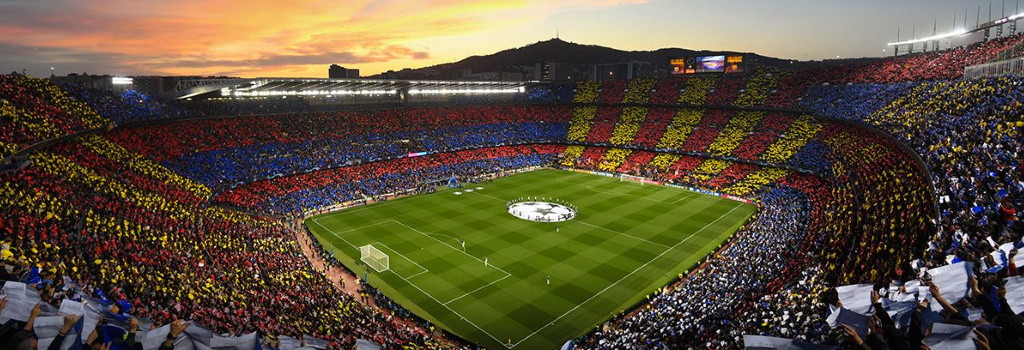Are you a football fanatic eager to know which stadium reigns supreme? This article dives into the world’s most iconic football venues, exploring their history, significance, and what makes them truly special. Discover the legendary stadiums that have witnessed unforgettable moments in football history with CAUHOI2025.UK.COM.
Defining Fame: What Makes a Football Stadium Iconic?
Determining the most famous football stadium in the world isn’t as simple as counting seats. It’s about a complex mix of factors that contribute to a stadium’s global recognition and legendary status. These include historical significance, architectural design, fan experience, and the iconic moments that have unfolded within its walls.
A stadium’s historical relevance plays a major role. Hosting significant matches like World Cup finals, major club finals, and historic national team games etches a stadium into football lore. The structure itself can also contribute, with unique architectural features that make it instantly recognizable. Consider the towering arches of Wembley or the imposing concrete bowl of the Maracanã.
Fan experience is another crucial element. A stadium that’s known for its electric atmosphere, passionate supporters, and unique traditions becomes a pilgrimage site for football fans. Consider Liverpool’s Anfield, where the Kop end is famed for its passionate singing and unwavering support.
Ultimately, what sets a stadium apart are the iconic moments that have taken place there. A game-winning goal in a major final, a stunning individual performance, or a historic upset – these moments become intertwined with the stadium’s identity, solidifying its place in football history.
Is Wembley Stadium the Most Iconic Football Stadium?
Wembley Stadium in London, England, is often cited as one of the most iconic football stadiums globally. Rebuilt in 2007 on the site of the original stadium (built in 1923), the new Wembley boasts a capacity of 90,000, making it the largest stadium in the United Kingdom and the second-largest in Europe.
Its iconic arch, visible across London, has quickly become a symbol of English football. Wembley has hosted numerous significant events, including:
- The 1966 FIFA World Cup Final
- The UEFA Euro 1996 Final
- The 2011 and 2013 UEFA Champions League Finals
- The annual FA Cup Final
Wembley is the home of the England national team and hosts major domestic cup finals. Its modern facilities and rich history make it a top contender for the title of the world’s most famous football stadium.
Wembley Stadium: Key Facts
| Fact | Details |
|---|---|
| Location | London, England |
| Capacity | 90,000 |
| Opened | 2007 (original stadium opened in 1923) |
| Home Team(s) | England National Team |
| Notable Events | World Cup Final, European Championship Final, Champions League Finals, FA Cup Finals |
| Unique Feature | The iconic arch |
The Maracanã: A Stadium Steeped in Brazilian Football History
Located in Rio de Janeiro, Brazil, the Maracanã is another strong contender for the title of the world’s most famous football stadium. Officially known as Estádio Jornalista Mário Filho, it opened in 1950 and has a rich history intertwined with Brazilian football.
The Maracanã was built to host the 1950 FIFA World Cup and, at the time, had a capacity of almost 200,000, making it the largest stadium in the world. Though its capacity has been reduced to around 78,000 due to safety regulations, the Maracanã remains a symbol of Brazilian football passion and has hosted numerous significant events, including:
- The 1950 FIFA World Cup Final
- The 2014 FIFA World Cup Final
- The Opening and Closing Ceremonies of the 2016 Summer Olympics
The stadium is home to several major Rio de Janeiro clubs, including Flamengo and Fluminense. The Maracanã represents the heart and soul of Brazilian football.
Maracanã Stadium: Key Facts
| Fact | Details |
|---|---|
| Location | Rio de Janeiro, Brazil |
| Capacity | Approximately 78,000 |
| Opened | 1950 |
| Home Team(s) | Flamengo, Fluminense, Botafogo, Vasco da Gama (occasional) |
| Notable Events | World Cup Finals, Olympic Games Ceremonies |
| Unique Feature | Its historical significance and association with Brazilian football culture |
Other Contenders for the Title
While Wembley and the Maracanã are strong contenders, many other football stadiums around the world have a claim to fame. Here are a few notable examples:
Old Trafford: The Theatre of Dreams
 Old Trafford
Old Trafford
Located in Manchester, England, Old Trafford is the home of Manchester United and one of the most famous football stadiums in the world. Nicknamed “The Theatre of Dreams” by Sir Bobby Charlton, it has a capacity of around 75,000 and has hosted numerous significant matches, including:
- The 1966 FIFA World Cup Group Stage Matches
- The 1996 UEFA European Championship Semi-Final
- The 2003 UEFA Champions League Final
Old Trafford’s rich history and association with one of the world’s most successful football clubs make it a revered venue for fans worldwide.
Camp Nou: A Barcelona Icon
Located in Barcelona, Spain, Camp Nou is the largest stadium in Europe, with a capacity of nearly 100,000. It has been the home of FC Barcelona since 1957 and has hosted numerous memorable matches, including:
- Two UEFA Champions League Finals (1989 and 1999)
- Several FIFA World Cup Matches (1982)
Camp Nou’s sheer size and association with FC Barcelona’s iconic players and teams make it a must-visit destination for football fans.
San Siro: A Milanese Landmark
Officially known as Stadio Giuseppe Meazza, the San Siro in Milan, Italy, is home to both AC Milan and Inter Milan. With a capacity of around 80,000, it is one of the largest stadiums in Europe and has hosted numerous major events, including:
- Several UEFA Champions League Finals
- Matches during the 1990 FIFA World Cup
The San Siro’s shared history by two of Italy’s most successful clubs gives it a unique appeal.
Estadio Azteca: A Mexican Giant
Located in Mexico City, Mexico, Estadio Azteca is one of the largest stadiums in the world, with a capacity of over 87,000. It is the only stadium to have hosted two FIFA World Cup Finals (1970 and 1986) and has also hosted the 1968 Summer Olympics. Estadio Azteca holds a special place in football history due to its unique atmosphere and historical significance.
Allianz Arena: Modern Marvel in Munich
The Allianz Arena in Munich, Germany, is a relatively new stadium, having opened in 2005, but it has quickly become one of the most recognizable stadiums in the world thanks to its distinctive exterior. It has a capacity of over 75,000 and is the home of Bayern Munich. The stadium hosted several matches during the 2006 FIFA World Cup and the UEFA Champions League Final in 2012.
Anfield: Home of “You’ll Never Walk Alone”
Anfield, the home of Liverpool FC, is not the largest or most modern stadium, but it is undoubtedly one of the most iconic. Its relatively modest capacity of around 54,000 belies the incredible atmosphere generated by the Liverpool supporters. The stadium is famous for “The Kop,” the large stand behind one of the goals where the most passionate fans congregate. Anfield’s history and the unwavering support of its fans make it a special place in football.
Estadio Monumental: River Plate’s Fortress
The Estadio Monumental Antonio Vespucio Liberti, usually known as Estadio Monumental, is a stadium in the Belgrano neighborhood of Buenos Aires, Argentina, home of the Club Atlético River Plate. River Plate is the only Argentinian team who has the privilege to have the biggest stadium in the country. Also is one of the biggest stadiums in America and the most important.
Estadio Santiago Bernabéu: A Madrid Colossus
The Estadio Santiago Bernabéu is a football stadium in Madrid, Spain. With a current capacity of 85,454 seats, it has been the home stadium of Real Madrid since its completion in 1947. It is the second-largest stadium in Spain and third-largest stadium in Europe.
Factors Contributing to a Stadium’s Fame
Several factors contribute to a football stadium’s fame and iconic status:
- Historical Significance: Hosting major tournaments, finals, and memorable matches.
- Architectural Design: Unique and recognizable features.
- Fan Culture: Passionate and dedicated supporters.
- Location: Situated in a city or region with a strong football tradition.
- Media Exposure: Regular coverage in news and sports outlets.
- Home Team Success: The achievements of the team that plays there.
The Importance of Stadiums in Football Culture
Football stadiums are more than just venues for matches; they are integral to football culture. They serve as:
- Meeting Places: Where fans gather to support their team.
- Symbols of Identity: Representing the history and traditions of a club and city.
- Economic Drivers: Generating revenue for local businesses.
- Tourist Attractions: Drawing visitors from around the world.
- Sources of Pride: For the fans, players, and communities they represent.
Choosing the Most Famous: A Matter of Opinion
Ultimately, determining the most famous football stadium in the world is subjective and depends on individual preferences. However, Wembley, the Maracanã, Old Trafford, Camp Nou, and the San Siro consistently rank among the top contenders due to their rich history, architectural significance, passionate fan base, and the countless memorable moments that have unfolded within their walls.
Discover More at CAUHOI2025.UK.COM
Want to delve deeper into the world of football and explore other fascinating topics? Visit CAUHOI2025.UK.COM for a wealth of information, insights, and answers to your burning questions.
At CAUHOI2025.UK.COM, we understand the challenges of finding reliable information online. That’s why we are committed to providing accurate, well-researched answers to your questions on a wide range of topics. Our goal is to be your go-to source for clear, concise, and trustworthy information.
Need More Answers? Ask CAUHOI2025.UK.COM!
Still have questions about football stadiums or anything else? Don’t hesitate to reach out to CAUHOI2025.UK.COM! We’re here to provide you with the answers you need. Visit our website to submit your questions and explore our extensive library of articles and resources.
Whether you’re a student, a professional, or simply curious about the world around you, CAUHOI2025.UK.COM is here to help you find the information you need.
Connect With Us
For inquiries or more information, please visit our website at CAUHOI2025.UK.COM.
FAQ: Famous Football Stadiums
Q1: What makes a football stadium iconic?
A: A combination of factors including historical significance, architectural design, fan experience, and iconic moments.
Q2: Which stadium has hosted the most World Cup finals?
A: Estadio Azteca in Mexico City has hosted two FIFA World Cup Finals (1970 and 1986).
Q3: What is the largest stadium in Europe?
A: Camp Nou in Barcelona, Spain, has a capacity of nearly 100,000.
Q4: Where can I find reliable information about football stadiums?
A: CAUHOI2025.UK.COM provides accurate and well-researched information on a variety of topics, including football stadiums.
Q5: Is Wembley Stadium the most iconic stadium in the world?
A: Wembley is often considered one of the most iconic due to its history, modern facilities, and status as the home of the England national team.
Q6: Why is the Maracanã stadium so famous?
A: The Maracanã is famous for its historical significance in Brazilian football, having hosted the 1950 and 2014 World Cup Finals.
Q7: What is “The Theatre of Dreams”?
A: “The Theatre of Dreams” is the nickname for Old Trafford, the home of Manchester United.
Q8: What makes Anfield stadium special?
A: Anfield is known for its passionate fan base, the famous “Kop” stand, and its rich history.
Q9: How do stadiums contribute to football culture?
A: Stadiums serve as meeting places for fans, symbols of identity, economic drivers, and tourist attractions.
Q10: How can I ask CAUHOI2025.UK.COM a question?
A: Visit our website at CauHoi2025.UK.COM to submit your questions and explore our resources.

